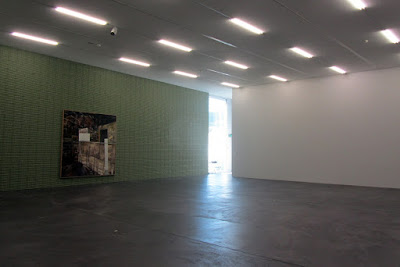skip to main |
skip to sidebar
Albert Oehlen: An Old Painting in Spirit - Kunsthalle Zürich. 30.05.2015-16.08.2015
Exhibition Text: Entitled Abräumung [Clearance], Albert Oehlen’s first major institutional solo exhibition took place in Kunsthalle Zürich in 1987. Now, almost thirty years later, Kunsthalle Zürich presents a second installment of works by this German painter, who was born in 1954 and has been living in Appenzell for over a decade. Shown in conjunction for the first time, An Old Painting in Spirit brings together important works from the 1980s, two new painting cycles and a selection of about fifty rarely shown drawings. The installation in Kunsthalle Zürich is laid out as if it were a group exhibition. The aim is to present the variety in Oehlen’s painting, making it apparant how he repeatedly subjects the medium to a stress test. Only when one steps up closer and takes a second look does the consistency of the painting process reveal itself.
 |
| Albert Oehlen (detail) |
 |
| Albert Oehlen (detail) |
 |
| Albert Oehlen (detail) |
 |
| Albert Oehlen (detail) |
 |
| Albert Oehlen (detail) |
 |
| Albert Oehlen (detail) |
 |
| Albert Oehlen (detail) |
 |
| Albert Oehlen (detail) |
 |
| Albert Oehlen (detail) |
 |
| Albert Oehlen (detail) |
 |
| Albert Oehlen (detail) |
 |
| Albert Oehlen (detail) |
 |
| Albert Oehlen (detail) |
Exhibition Text Continued:The early brown-grey pictures, offset with mirrors, originate in the era of the “rediscovery” of painting in the late 1970s. This renewed interest emanated from the Italian Transavanguardia, the so-called “Neue Wilde” in Germany, Austria and Switzerland and also through American artists such as Julian Schnabel. All of it amounted to a big wave of expressive, figurative painting,
which was no less celebrated than attacked. A “hunger for pictures” and a booming art market turned some artists into stars. Many have now been forgotten. In the case of others it was only later that it become apparent that they were concerned with something more than “savage” painting, Neo-Expressionism and sentiment. On the surface Oehlen seemed to be one of many, but it gradually became clear that he was working on a different project: His purpose was to examine painting by means of painting, to experiment with its options and to make space for it (and consequently us). Already in the 1980s this is hinted at through the pictures’ titles, which are sometimes serious, sometimes ironic and sometimes cryptic. They appear to be explaining the work, but simultaneously undermine that expectation. Something similar can be said of the mirrors that are attached to the paintings. In an imaginable, simple and platitudinous way they extend the pictoral space so that everyone believes they are looking
at a different picture. In this way these works precisely and laconically hook into the at the time passionately conducted debates around the question of painting and illusion.
The second group of works are large-scale collages from 2009 and 2010 in which Oehlen uses supermarket posters in lieu of brushes and paints. Is this really painting, and if so why? Or is something analogous to the manner of Photoshop being carried out? Is this Pre-Post-Internet art? Or is it about something completely different, namely the question of how much resistance
found material has, to what extent it can be disempowered without it losing its potential. - And whether such potential (in this case, advertising) can be heaved into a different condition. The result is a series of large-format tableaus that lack any surreal effects (otherwise customary
for collages) but are unique non-figurative forks, which—unlike the paintings from the 1980s—hardly make up any image at all, as if one could no longer see the wood for the trees.
The third group is a series of recent paintings, which are shown here for the first time. Tree-
like black forms spread out on red-white or blue-white backgrounds, unromantically and harsh in style. While the early pictures and large-scale collages approach or emerge from the outer world, these latest works appear to be units enclosed within themselves and therefore independent.
They are juxtaposed with wall-covering egg cartons in the upper exhibition rooms, which were brought in to improve the space acoustics for the opening night concert by the trio Wertmüller–Pliakas–Wittwer. At the same time they insulate the room so that, like the tree pictures, it has become a unit cut off from the outside world. That has something calming, but also disturbing about it.
KUNSTHALLE ZÜRICH

























No comments:
Post a Comment